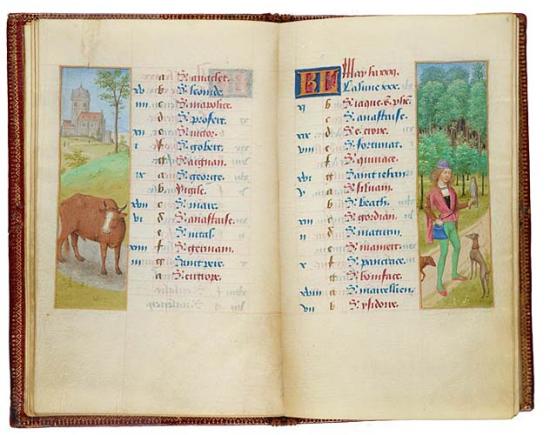
Book of Hours, in Latin and French
Illuminated by Simon Marmion
Purchased by Pierpont Morgan, 1900
Calendars in prayer books are often excellent sources for depictions of contemporaneous clothing. The month of May, shown here on the right, is illustrated by the leisurely occupation of hawking. The youth wears a gown with slit sleeves and a skirt so short it no longer covers his crotch. The tan sleeves and black front of his doublet and, at his neck, the top of his linen shirt are all visible. The lilac of his hat and pink of his shoes were favorite colors of the illuminator, Simon Marmion. (On the left is Taurus, the zodiacal sign for the month of April.)
Late Gothic Vertigo
In the 1460s and '70s fashions reached their Gothic climax. The look for both men and women was tall, long, and lean. Thin was in.
The look for men was dominated by the gown, worn either very short (to the crotch—or barely so) or very long (to the ground). Both versions, accented by a thin belt around a narrow waist, featured high padded shoulders and pleats that flared down over the buttocks and up over the back and chest. These features, developed during the previous decades, brought to a culmination the flatteringly masculine V-shaped silhouette. Pouleines, which accented the lean look, were revived. The chaperon, in fashion for over a hundred years, finally went out of style as new hats–especially a tall, loaf-shaped version—arrived.
Women's gowns continued with their wide V necks, high wasp waist, and long trains. For headgear, temples went out of fashion and were replaced by the turret. This cone-shaped coif, from the tip of which cascaded transparent veils, is perhaps the stereotypical ladies' hat from the late Middle Ages.
